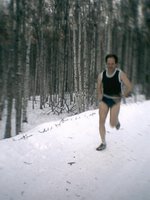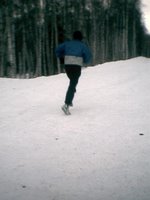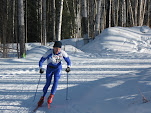Ski racing has many similarities with running, and there is a strong crossover element between the sports, but they can be quite different. Sunday's "January Jaunt" 20k classic race happened to be a runners day. Fairbanks has been socked in its longest cold snap of the year for the past week, with temperatures bottoming out at -42 on Friday morning. In spite of the cold, however, the area received a couple inches of fresh snow (the first in more than 6 weeks) on Friday afternoon.
I woke up Sunday morning not sure if they'd even have the race (-20 is the cutoff here), at -15 I knew it would be a go, albeit marginal. But I was bouyed to see an extra 2-3 inches of snow on the ground. Good for a former Colorado boy who grew up skiing on soft dry snow. Those conditions would make all the difference on this chilly morning when 80% of sports loving America was watching NFL playoffs.
Spent too long getting all my gear together--some 25 pieces of clothing, waxes, boots, sport drink, food, skin cream for my face, and in case I aspirate some gunk mid-race, an asthma inahaler, which I'd carry in a fanny pack. Left the house 15 minutes behind schedule, which would mean I'd only have a half hour once I got there. With classic racing you should really arrive close to an hour ahead. Two miles out from home I realized I'd forgotten something important: my skis! Didn't get to Birch Hill until 10:40, barely enough time to grab my bib, hit the loo, and get my boots on. No time to test waxes--a MUST for classic races--and only got to the start line with enough time to do a couple 100 m stride outs. Forgot the skin cream, and didn't have enough time to ge my bib on properly (the elastic band kept popping off!), and I resigned to just having it flop around my chest for 20 cold kilometers.
With no warmup, I saw no sense in going hard, and the first 2 kilometers looked like the grim same old: skiing several minutes behind these guys, in no-man's land fending off skiers from behind.
Masters rival (Bad) Bob pulled away along with Bruce, one of the town's best classic skiers, and another racer in a 90s-dated, all-Alaska, ski suit. Bob and Bruce had beaten me handily, both by more than 2 minutes, last week on a 10k over much the same course but with fast hard-pack conditions where our skis just zinged over the snow. Sunday was nearly silent, with sound muted. Bruce 100 meters ahead in a guady pastel ski suit, that looked like a Monet sunset, and Bob wore his ubiquitous bright orange top--a burning haystack. I shouldn't be thinking like that in the middle of a 20k!
Up the first substantial climb Bob fell back from the leaders--he skis with an imacculate and powerful classical stride--but it looked like he was struggling. Could I be catching him? Within a k I was right on his tail, and he stepped aside. I said HIYA HIYA! (Scando-speak for GO GO!). I think he just said "Hey there." I expected him to blast buy again at any moment, but he didn't. And for some reason, Bruce and the Alaska skier were not pulling away. I'd gain on steeper and long climbs, but would fall back on the crest as they used their powerful upper body strength to double pole away. So they'd hit the downhill with more momentum. But on the outrun, I'd gain a few ticks by holding my tuck just a little longer. On this hilly course, the pattern would repeat itself another dozen times or more.
Hit the 10k about 30 seconds back in a very slow 40 minutes (we were all low 31 to high 33 last week), feeling quite suprised to have them in sight. Over the next 5k, I gained a little more with each hill climb, and by 16k I pulled up right behind them. It became a tactical 3-man race, with the Alaska skier setting the pace. Bruce would try to pass him on some of the uphills only to be held off. Both were so much bigger and stronger, but on this day's soft slow snow, my runner physique had the advantage.
I could have just cruised behind them and finished a solid 3rd--in what would be my best ski race in a decade. With about 1.5 k to go, at the base of one of the longest climbs on the course (about 1.5 to to 2 minutes of moderate-almost steep climb) I decided to make a bold move. The course finishes on a half k of flat terrain. They would eat me up on that. So I bolted at the base of the hill, knowing full well that this was going to hurt bad.
My legs and lungs were out of gas near the top, and I slowed to a walk for a few strides. But they were a good 50 meters back already, with only a k to go, I figured I pretty much had it. This last k may have been the most painful of my running-skiing career, which includes about 500 or 600 races over 30 years. On the last stitchback I coughed and spit, but right into my balaclava, which was over my mouth....No choice but to pull that below my chin. My face instantly froze. My throat tighened and I almost gagged--my biggest fear is to choke up, and have a severe asthma attack. Into the stadium I skied frantically--my form (never as good as Bruce's smooth and powerful stride) had already fallen apart on the hill and it was getting worse by the second). I double polled, gasped, and my face hurt as if someone was pinching it. Around the last turn I had at least 70 meters on Bruce. I'd win for sure.. I thought. Crossed the line and collapsed. Bruce came in just a few seconds later.
I couldn't talk, could barely breathe, and had a knife-like pain over my lower face. This was the closest I've ever come to crying at the end of a race. And it wasn't from emotion. It hurt.
Stood up and former Olympic ski coach John Estle saw that I had white patches on my face. He put his and on them for a minute or two, as if to keep my face from falling off. I got inside as soon as I could and just sat there in a daze for several minutes until other skiers trickled in. The frostbite wasn't bad.
47 year old skier has beens aren't supposed to win races! What happened? Well like runners, skiers can always come up with a ton of excuses for why things didn't go their way...however skiing's toolbox of explanations is much deeper and tiered. Whereas in running you have your fitness and mental approach, the day's conditions, the course, and sometimes a shoe issue...and that's about it. Skiing has those factors and more. Weather and snow can make a huge difference not to mention waxes and skis.
On this day, despite being poorly prepared at the start, the conditions all fell into my favor. These are my positive exuses for an unlikely win (no EPO required): Lighter skiers generally do better on soft snow. My competitors were 30-50 pounds heavier. If a couple of the other lighter runner/cyclist skiers had show up (let alone the UAF squad, who were racing in Minnesota)...the outcome may have been quite different. My conditioning and turnover as a runner were able to compensate for their more powerful and fluid strides. Even though we were at only 800-1000 feet above sea level, the feel was much like the racing at 9,000 feet in Colorado. Lung power helped rule the day. Bruce put it as a day for "those bird leg runners with big lungs." At cold temperatures, waxing is less of an issue, but I was lucky to hit it without need for an adjustment. I sometimes complain about the hilly courses at Birch Hill (this had 32 meters per kilometer of climb), which requires too much anaerobic chutzpah for a skinny distance runner. But with slow snow, it became more of an aerobic fest at my best distance. Finally skis. My skis are soft--usually too soft for my liking--and on the new snow they were near perfect.
This is a win that I'll savor for a long time. It took luck, and a bit of Sisu! (Finnish for guts and resovle in the face of adversity) because I know that a repeat will be real tough.





